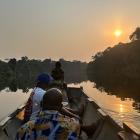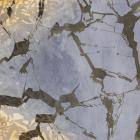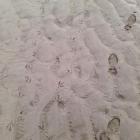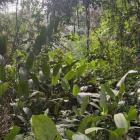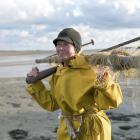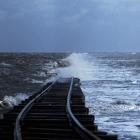Narratives
Narratives weave together symbols and imaginaries to provide ways of understanding the world. Temporal narratives are attempts to make sense of moments, events, and processes as stories, histories, or memories. But in wetland spaces, the difficulty of crafting linear narratives in constant motion becomes clear. Colin Williams describes the Wadden Sea as open ended, evoking Shakespeare’s The Tempest: “What is past is prologue.” The Wadden coast does not offer tidy conclusions—it is a story still being written, with each tide adding and erasing. Morecambe Bay, too, holds history and memory in unpredictable ways. Objects lost to the tides—shoes, cockle bags, fragments of boats, vehicles, and even massive shipping containers—sometimes reappear unexpectedly, as if the Bay momentarily reveals a glimpse of its buried archive before concealing it again.
The sands are an impermanent record of a million natural transactions.
—Colin Williams

Figure 8: “Vehicle swallowed by the sands,” Hest Bank. Photograph by Enaiê Mairê Azambuja, February 2025.
Figure 8: “Vehicle swallowed by the sands,” Hest Bank. Photograph by Enaiê Mairê Azambuja, February 2025.
© 2025 Enaiê Mairê Azambuja. Used by permission.
The copyright holder reserves, or holds for their own use, all the rights provided by copyright law, such as distribution, performance, and creation of derivative works.
Human memory in these wetlands is layered and fragmented. Morecambe Bay’s sands are an unpredictable recordkeeper. Writer and artist Sarah Hymas recalls watching a Land Rover swallowed by the sands, only for it to reemerge a decade later—an uncanny reminder that the Bay does not so much erase as conceal, holding memories in suspension beneath its surface. Today’s footprints on Sunderland Point might one day be uncovered, much like the Neolithic tracks along the Lancashire coast. This underscores the strange continuum of time in the Bay, where the footprints of modern walkers briefly intersect with those of ancient beings—separated by millennia yet momentarily revealed by the shifting sands and tides.

Figure 9: “Footprints,” Hest Bank. Photograph by Enaiê Mairê Azambuja, February 2025.
Figure 9: “Footprints,” Hest Bank. Photograph by Enaiê Mairê Azambuja, February 2025.
© 2025 Enaiê Mairê Azambuja. Used by permission.
The copyright holder reserves, or holds for their own use, all the rights provided by copyright law, such as distribution, performance, and creation of derivative works.
Wetlands are sites of crossing, where human and nonhuman journeys intersect: storms scar the land, tides reshape it, and migratory birds mark its seasons. In Morecambe Bay, these crossings hold deep histories, from the WWII-era concrete pillars at Hest Bank and hidden bunkers among the dunes, to much older routes like “Priest Skear,” where monks once paused while guiding travelers across shifting sands. The Old Norse skear, meaning rocky reef or outcrop, hints at the Bay’s layered cultural past. Across tides, time, and tradition, the landscape bears witness to movement within its unpredictable terrain.
To speak of wetlands is to speak of temporalities in tension—of rhythms interrupted, traditions obscured, and ecologies frayed by the mechanics of progress. At the same time, the globally dominant post-Enlightenment hegemonic narrative of progress is itself challenged by wetland times. Fractures caused by industry, land reclamation, and climate change expose the limits of mastery and the illusion of linear progress.
This experience is not unique to Europe. In the Dja-Et-Lobo region in southern Cameroon, climate change is widely felt and equally inexplicable. The wetlands are drying up earlier than before, though in some places and times they appear wetter. Rainfall has become more unpredictable, damaging crops and disrupting established seasonal patterns. Forest plants flower at unexpected times, unsettling normal cycles of activity. The Baka’s deep attunement and reliance on these natural rhythms make them particularly vulnerable, as almost every aspect of their lives is exposed to natural variation. For example, in the wetlands, raffia palms traditionally produced abundant white worms, a vital food source. Storms would cause some palms to fall and rot, creating conditions for worms to thrive; during the dry season, the worms could then be harvested. Elephants historically played a role by pushing down raffia palms, helping to maintain this cycle. However, with elephant populations now depleted, this natural process is disrupted, adding to the uncertainty faced by the Baka.

Figure 10: ”Wetland Path,” Dja Faunal Reserve, Cameroon. Photograph by Blake Ewing, January 2025.
Figure 10: ”Wetland Path,” Dja Faunal Reserve, Cameroon. Photograph by Blake Ewing, January 2025.
© 2025 Blake Ewing. Used by permission.
The copyright holder reserves, or holds for their own use, all the rights provided by copyright law, such as distribution, performance, and creation of derivative works.
Meanwhile, the Baka are prone to fold other events into a climate narrative. One man from a village very near the Dja Reserve noticed that people fall sick more often. Women are catching fish with sores on their skin. Still, they are not sure how to respond. Before, when it rained during the dry season, there was a way to prevent it by finding a termite mound (èjèmbèlèmbè) in which snakes, scorpions, and ants also lived. “We would set it on fire,” explained one man, “and it would burn for a month, preventing the rain from falling and allowing us to carry out our activities.” Some remark speculatively that perhaps God is angry and punishing the government for expelling the Baka from their ancestral forests, since they no longer harvest their fruits and can no longer perform their rituals in the right places and at the right times. Most agree that the wetlands are especially vulnerable to climate change. Within conservation circles, peat bogs have gained renewed prominence as critical carbon sinks, strengthening arguments to protect these ecosystems. However, this focus on “saving” the landscape often involves complex and sometimes contentious decisions, including restrictions on local communities’ access and traditional practices. In some cases, conservation efforts have led to the exclusion of Indigenous peoples, raising important questions about whose voices and needs are prioritized in protecting these environments.
But elsewhere, the story of wetlands takes a different turn—one of containment rather than attunement. Take dykes: Their construction marks a historical shift from the adaptive living of mound settlements—where people cohabited with water and its rhythms—to the dogma of enclosure and drainage. As researcher Marjolijn Dijkman observes, in the Wadden Sea this transition parallels the Christianization of the region, where churches rose at the center of reclaimed lands, replacing pools of tidal memory with stone altars of certainty. This “civilizing” of the wetlands was a conquest—not just of land, but of time. In sealing off the sea, the wetlands were fixed into a human pace, severing seasonal fluctuations and tidal intrusion. The dykes, once engineered symbols of protection, have become double-edged monuments of colonial ambition and environmental control. Yet even this engineered present is unstable. Rising sea levels, extreme storm surges, and the exhaustion of the land signal the fragility of control. Gas extraction has triggered earthquakes, damaging homes and shaking the very foundations of these reclaimed zones. The sea, it seems, is restless.
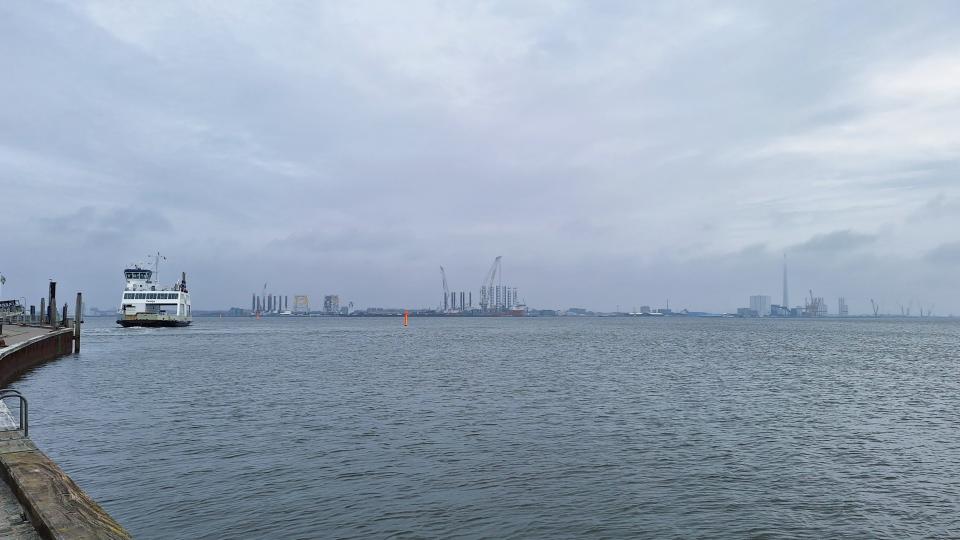
Figure 11: View of Esbjerg from Fanø, Danish Wadden Sea. Photograph by Enaiê Mairê Azambuja, March 2025.
Figure 11: View of Esbjerg from Fanø, Danish Wadden Sea. Photograph by Enaiê Mairê Azambuja, March 2025.
© 2025 Enaiê Mairê Azambuja. Used by permission.
The copyright holder reserves, or holds for their own use, all the rights provided by copyright law, such as distribution, performance, and creation of derivative works.
The Wadden’s towering dykes sit beside the Esbjerg industrial area—a sprawling, mechanized world that cleaves apart ancestral rhythms and lifeways. Esbjerg embodies the contradictions of progress with particular force. Once a modest fishing town, it is now a node of extractive industry and renewable energy, where oil rigs share the skyline with offshore wind farms. The town’s evolution into a hub for wind-turbine assembly and power-to-x technologies (converting renewable energy into hydrogen and synthetic fuels) may signal a green future, but it also brings profound ecological consequences.
In nearby Tøndermarsken, wind farms disrupt migratory paths of birds, fracturing the choreography of flight that once defined the wetlands. The mechanical presence of turbines reshapes the sensory field—soundscapes, light patterns, nesting sites—all altered under the pressure of progress. This paradox of green energy as both solution and disruption extends further through the presence of AI technologies and data infrastructure, like the Google data center in Eemshaven (The Netherlands) that now warms the waters of the Ems estuary through its industrial cooling process.
Here, the virtual meets the visceral—our digital searches, abstract and invisible, imprint heat into a fragile, silting landscape. The critical mass of dredged sediment and rising water temperatures reflects a technoecological entanglement few acknowledge. These wetlands, shaped for centuries by the tension between land and sea reclamation, now also negotiate the specter of a “cyborg” landscape—controlled by algorithmic logic, predictive modeling, and remote computation.
Keywords: history, memory, tradition, progress
Link words: cycles, archives, rhythm, ruptures, impermanence, structures, adaptation, reclamation, memory, season, tradition, future






